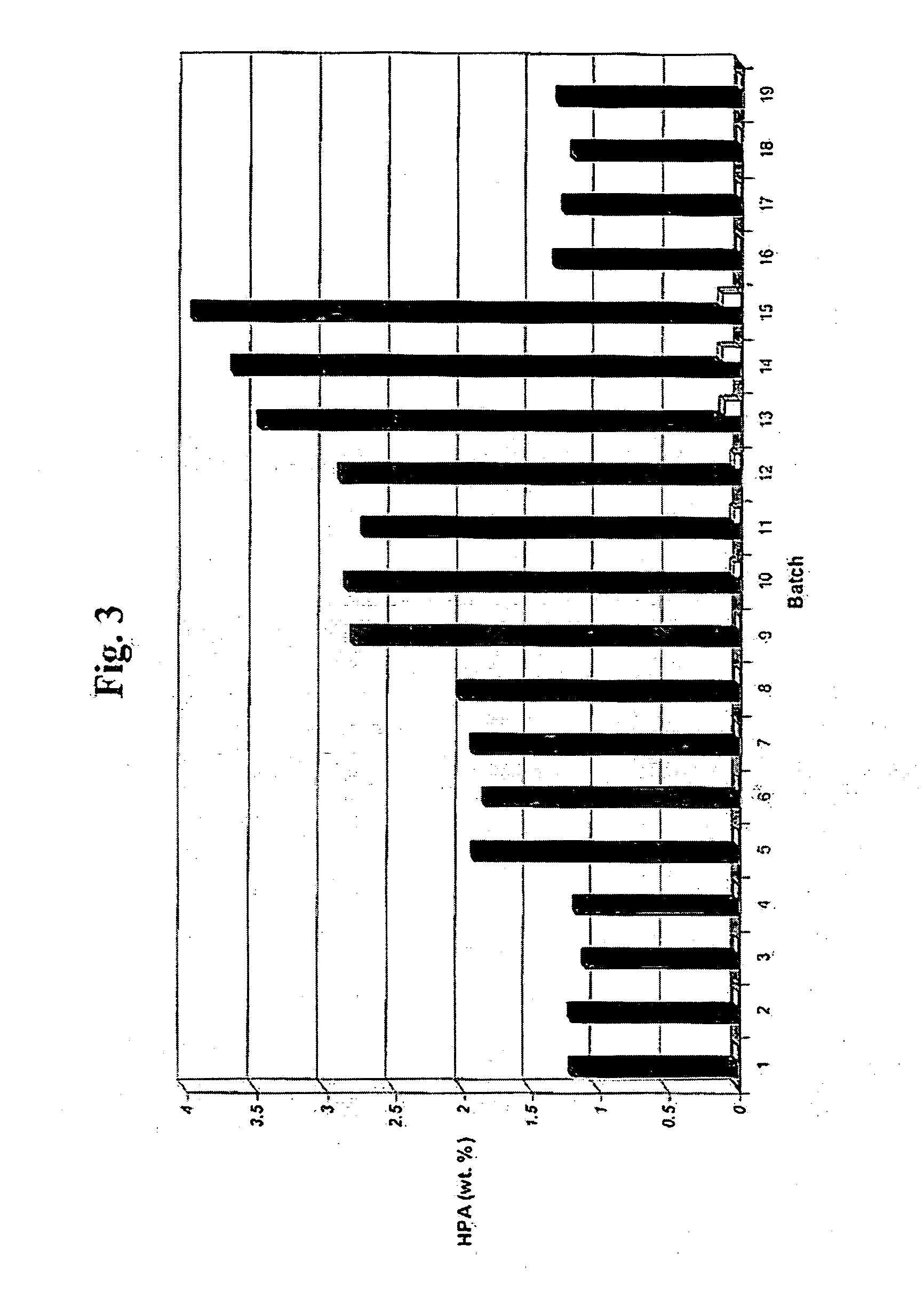Hydrogenation catalyst and hydrogenation method
a hydrogenation method and catalyst technology, applied in the field of hydrogenation catalysts, can solve the problems of reducing the life of the catalyst, reducing the crush strength of the catalyst, and slurry catalysts, etc., and achieves the effects of high hpa rate, high volume/time yield of pdo from hpa, and high degree of selectivity
- Summary
- Abstract
- Description
- Claims
- Application Information
AI Technical Summary
Benefits of technology
Problems solved by technology
Method used
Image
Examples
example 1
[0075] A catalyst according to the present invention was prepared comprising an α-alumina support, nickel, ruthenium, and rhenium, where the nickel is deposited on the α-alumina support and the ruthenium and rhenium are deposited on the nickel and on the α-alumina support. The catalyst was prepared such that the catalyst contained 2.5 wt. % nickel, 1 wt. % ruthenium, and 1 wt. % rhenium.
[0076] Gamma-alumina tri-lobe pellets were calcined at 1275° C. to prepare the α-alumina support. An aqueous nickel solution was prepared by dissolving 3.5 grams of ammonium carbonate in 15 ml of ammonium hydroxide solution (25%) with moderate heat and stirring, followed by the addition and dissolution of 6.8 grams of nickel carbonate in the ammonium carbonate / ammonium hydroxide solution. The solution volume was brought to 40 ml with additional ammonium hydroxide solution (25%). 100 grams ofthe α-alumina support was impregnated with the nickel solution, absorbing 100% of the solution volume. The nic...
example 2
[0079] Hydrogenation of HPA to PDO was effected with a catalyst in accordance with the present invention having nickel deposited on an α-alumina support, and ruthenium and rhenium deposited on the nickel and the support. The catalyst contained 2.5 wt. % nickel, 1 wt. % ruthenium, and 1 wt. % rhenium.
[0080] The catalyst was prepared in accordance with the procedure described in Example 1, where the activated catalyst was maintained under liquid PDO after activation and prior to hydrogenation. A 21 ml volume of the catalyst, with a catalyst density of 0.70 g / cm3 and a void fraction of 0.42, was loaded into a batch hydrogenation wire basket to provide a catalyst charge of 14.7 grams, which was then topped with a ⅛″ layer of inert denstone to prevent the catalyst from moving during the hydrogenation. The basket containing the catalyst was then secured in the cooling coils of a batch hydrogenation reactor. The catalyst was then rinsed three times with deionized nitrogen sparged water.
[...
example 3
[0086] Hydrogenation of HPA to PDO was effected with a catalyst of the present invention having nickel deposited on an α-alumina support, and ruthenium and rhenium deposited on the nickel and the support, where the catalyst had been dried and exposed to air under ambient conditions prior to hydrogenation. The catalyst contained 2.5 wt. % nickel, 1 wt. % ruthenium, and 1 wt. % rhenium.
[0087] The catalyst was prepared in the same manner as the catalyst in Example 1, except the activated catalyst was exposed to air at ambient conditions prior to being loaded into a hydrogenator. A 21 ml volume of the activated catalyst with a catalyst density of 0.94 g / cm3 and a void fraction of 0.42 was loaded dry into a batch hydrogenation wire basket to provide a catalyst charge of 19.7 grams, which was then topped with a ⅛″ layer of inert denstone to prevent the catalyst from moving during the hydrogenation. The basket containing the catalyst was then secured in the cooling coils of a batch hydrog...
PUM
| Property | Measurement | Unit |
|---|---|---|
| wt. % | aaaaa | aaaaa |
| hydrogen pressure | aaaaa | aaaaa |
| temperature | aaaaa | aaaaa |
Abstract
Description
Claims
Application Information
 Login to View More
Login to View More - R&D
- Intellectual Property
- Life Sciences
- Materials
- Tech Scout
- Unparalleled Data Quality
- Higher Quality Content
- 60% Fewer Hallucinations
Browse by: Latest US Patents, China's latest patents, Technical Efficacy Thesaurus, Application Domain, Technology Topic, Popular Technical Reports.
© 2025 PatSnap. All rights reserved.Legal|Privacy policy|Modern Slavery Act Transparency Statement|Sitemap|About US| Contact US: help@patsnap.com



